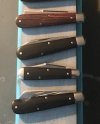- Joined
- Dec 2, 2005
- Messages
- 71,088
I have a garden bench made from teak. Teak is classed as a hardwood, but it's very light, not as light as balsa, but light enough for a middle-aged man to be able to move an 8ft bench made from it, around the garden, unaided, if needed. The teak was salvaged from an old British ship which was captured by the French at the 1805 Battle of Trafalgar. After being recaptured, the ship was put back into service, and sank on two occasions. After being decommissioned, it was broken up, and at the beginning of the 20th century, some of the teak timbers were made into garden furniture, such as benches and tables. My bench is of the type that graced England's public parks at one time. I have had it about 13 years, and it sits at the front of my house. It's never been varnished or treated in any way. Seems to be doing OK. The same could be said for my old wood-handled knives, the covers are often in better nick than the blades :thumbup:




















